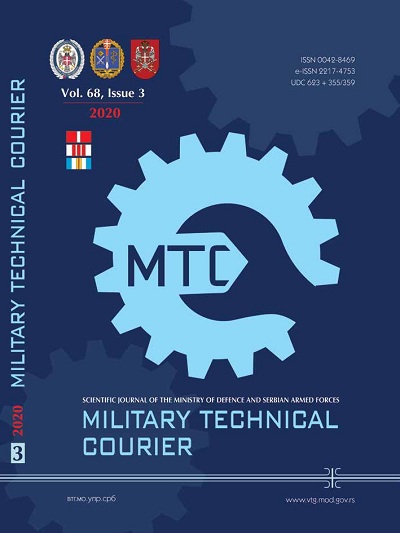Monitoring COVID-19 is like instrument flying
Abstract
Introduction/purpose: For the purpose of monitoring the COVID-19 epidemic in every single country in the world, this team has developed a specific system that consists of the following diagrams and mathematical models: а) epidemiological curve, b) histogram of infected people, c) histogram of infected people in last five days, d) double logarithmic curve for monitoring the speed of the epidemic, e) epidemic pipeline, and f) Gaussian and Boltzmann S curves. As it is shown in this paper, monitoring an epidemic is like flying a plane using instruments.
Methods: The most complex model is the calculation of the truncated Gaussian curve, and this model will be discussed in more detail in this paper. Also, there is time coincidence between the Gaussian curve and the S-curve. The input data were found in the World Health Organization daily reports. The full set of data consists of: the Gaussian curve, the double logarithmic curve and the epidemic curve. In some cases, using only one of the three specified parameters in not enough.
Results: For the purpose of proving specified methodology, the paper has dozens of results in the form of diagrams.
Conclusion: The Gaussian curve was formed, and the end of the epidemic was calculated. But, in some cases, the epidemic curve was not well formed (the end of the epidemic is not clear since many countries did not declare the number of recovered people in a proper way). This is the reason why we must include a flow of the double logarithmic curve into consideration. Only a combination of these three diagrams can give a right insight into the right decision.
References
Ferguson, N.M., & et al. 2020. Impact of non-pharmaceutical interventions (NPIs) to reduce COVID19 mortality and healthcare demand. Report 9, Imperial College London, pp.1-20. Available at: https://doi.org/10.25561/77482.
Flaxman, S., & et al. 2020. Estimating the number of infections and the impact of non-pharmaceutical interventions on COVID-19 in 11 European countries. Report 13, Imperial College London, pp.1-35. Available at: https://doi.org/10.25561/77731.
Gauss, C.F. 1809. Theoria motus corporum coelestium in sectionibus conicis solem ambientium. Hamburgi: sumtibus Frid. Perthes et I. H. Besser (in Latin). Available at: https://doi.org/10.3931/e-rara-522.
Kočović, P. 1998. Geometrijsko modeliranje, vol 1. Belgrade: Petar Kočović (in Serbian).
Kočović, P. 2020. Petar Kočović - Gausova kriva i prognoza COVID-19 epidemije [online] Available at: https://www.youtube.com/watch?v=4kguYa7Po2U [Accessed: 29 April 2020].
Kočović, P., Kočović, Z., & Kočović, V. 2020. Petar Kočović's COVID-19 statistics and trends [online]. Available at: http://digital-dreams.biz/COVID-19/index.php [Accessed: 29 April 2020].
Laplace, P.S. 1774. Mémoire sur la probabilité des causes par les évènements. Mémoires de Mathematique et de Physique, 6, pp.621-656 (in French) [online]. Available at: https://www.biodiversitylibrary.org/item/86068#page/7/mode/1up [Accessed: 1 May 2020].
Mann, P.S. 1994. Statistics for Business and Economics. Hoboken, New Jersey: Willey.
-McKinsey & Company. 2020. COVID-19: briefing Materials [online]. Available at: https://www.mckinsey.com/~/media/mckinsey/business%20functions/risk/our%20insights/covid%2019%20implications%20for%20business/covid%2019%20april%2013/COVID-19-facts-and-insights-april-24.ashx [Accessed: 12 April 2020].
Reséndiz-Muñoz, J., Corona-Rivera, M.A., Fernández-Muñoz, J.L., Zapata-Torres, M., Márquez-Herrera, A., & Ovando-Medina, V.M. 2017. Mathematical model of Boltzmann's sigmoidal equation applicable to the set-up of the RF-magnetron co-sputtering in thin films deposition of BaxSr1-xTiO3. Bulletin of Materials Science, 40, pp.1043-1047. Available at: https://doi.org/10.1007/s12034-017-1441-x.
Stahl, S. 2006. The Evolution of the Normal Distribution. Mathematic Magazine, 79(2), pp.96-113. Available at: https://doi.org/10.1080/0025570X.2006.11953386.
-World Health Organization. 2020. Coronavirus disease (COVID-2019) situation reports [online]. Available at: https://www.who.int/emergencies/diseases/novel-coronavirus-2019/situation-reports/ [Accessed: 18 May 2020].
Proposed Creative Commons Copyright Notices
Proposed Policy for Military Technical Courier (Journals That Offer Open Access)
Authors who publish with this journal agree to the following terms:
Authors retain copyright and grant the journal right of first publication with the work simultaneously licensed under a Creative Commons Attribution License that allows others to share the work with an acknowledgement of the work's authorship and initial publication in this journal.
- Authors are able to enter into separate, additional contractual arrangements for the non-exclusive distribution of the journal's published version of the work (e.g., post it to an institutional repository or publish it in a book), with an acknowledgement of its initial publication in this journal.
- Authors are permitted and encouraged to post their work online (e.g., in institutional repositories or on their website) prior to and during the submission process, as it can lead to productive exchanges, as well as earlier and greater citation of published work (See The Effect of Open Access).

